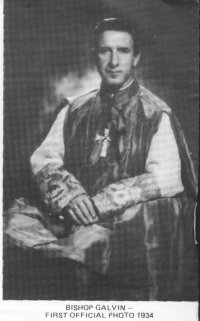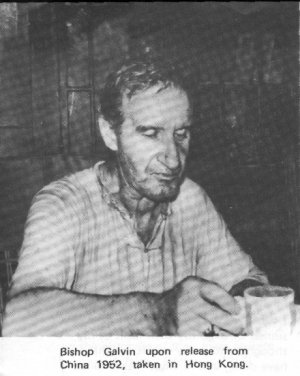|
|
Kilmurry Parish Website. RESOURCES
FOR A HISTORY OF KILMURRY PARISH This document is taken from
What followed clearly showed the Hand of God at work. Fr. Galvin was shocked at the poverty and misery he saw in the province of Chekiang. The spiritual poverty of the vast population moved him even more and he began a series of letters to students and priests at Maynooth College, appealing for more priests to join him. "More priests ... you get to that whenever you begin." By 1915, two priests had joined him -- Fr. Patrick O'Reilly and Fr. Joseph O'Leary. They were insistent that he go back to Ireland and organise the new mission. Fr. Galvin wouldn't hear of it: "I am a nobody, just a plain, ordinary China missionary. I am not known in Ireland. It's a job for someone else." In the end, they agreed of offer a Novena of Masses. "When the Novena was completed", Bishop
Galvin wrote later, "we knelt down in my room
facing each other. I cut the leaves of our Bible and on the top of
the righthand page read the following verse: First stop on his way home was in the USA at Chicago. At Chicago he obtained the warm approval of Archbishop Mundelein. That was a crossroads. American support was assured. He reached Dublin in August 1916. Great changes had come to pass in the seven years since he had left Ireland, not least in that historic year of the Easter Rising. Now, Fr. Edward Galvin and and his companions (numbering six by October) were to bring about another kind of change that would sweep the country. Fr. Blowick of the Maynooth College staff had joined them and it was he who presented the appeal to the Bishops of Ireland at their October meeting. On October 11th, the Hierarchy voted in favour of the new Missionary Society. Another crossroads had been reached. The new Society became "St. Columban's Foreign Mission Society" and, in time, became known as 'The Maynooth Mission to China'. It was dedicated to Fr. Galvin's own patron, Columbanus, on whose feast he had been born. From there on, nothing could hold up progress. More recruits joined them, funds were raised in every corner of the land, a home was found at Dalgan Park, Galway and Pope Benedict XV gave his blessing to the new venture. By 1920, there were forty priests enrolled and a mission territory had been assigned. A new and powerful force was a work. The foundation had been well laid. From there on, Fr. Galvin was happy to be where the action was -- in China. And action there certainly was! There were two and a half years of peace during which the missionaries set about teaching, preaching, bringing the sacraments, saying Mass. Gradually, however, the Chinese government seemed to lose its grip until, particularly in Hanyang (the Columban territory) it was almost a free-for-all, as local warlords fought one another and the bandits took over. It took remarkable courage from the Irish missionaries to stick to their task. Robert T. Reilly describes it:
By 1925, the left wing of the Nationalist Party was beginning to assert itself; more and more went communist and anti-foreign demonstrations swept the country. Priests and nuns were prime targets. Again, to quote Robert T. O'Reilly:
In spite of it all, the work went on, Hanyang was declared a Vicariate (diocese) and Fr. Galvin became Bishop Galvin in November 1927. Meanwhile, a new name began to dominate the Nationalist Party -- Chiang Kai Shek -- and he soon rallied all the country behind him -- all except two communist-controlled areas and in each of those the Columbans were working; Hanyang (their original foundation) and Nancheng (their newest mission). Nancheng gave its first martyrs to the Maynooth Mission to China: Fr. Tim Leonard was captured while saying Mass and stabbed to death; Fr. Con Tierney died after a lengthy captivity in communist hands. It was Holy Week 1930 when the communists confronted Bishop Galvin in person. He showed enormous courage and amazing coolness. Leading the sisters to a mariculous safety and interceding successfully for the two priests who had been taken away to communist HQ. The following year, 1931, Bishop Galvin displayed the same practical courage when a disastrous flood -- the worst for 60 years -- hit the valley of the Yangtze river. Two thirds of the Hanyang vicariate was under water, 12,000 Chinese drowned, 23 million were destitute and 50 million people suffered serious loss. The work he did, the leadership he gave, the fatigue he endured were further proof of the extraordinary faith and humanity of the man. After the floods had receded and the reconstruction had started a new "Golden Age" began for the Church. There was a new interest, surpassing anything previously experienced by the missionaries, converts poured in, more than 40,000 pagans were instructed and baptised in the space of eight years. Over it all presided Wo-Ti Chu Chiao -- "Our Bishop", a plain simple man with the heart of a child and the strength of a giant. As always, the years of peace were soon forgotten. On July 7th 1937 Japan invaded China. Now the problem was how to come to the help of people shattered by daily air-raids and devastated homes. Once more, the Bishop was a tower of strength and played a key role, especially when Hanyang was occupied by the Japanese. Seven years were to pass before an uneasy peace settled again on Hanyang. The Japanese, vanquished, left for home but, in his mind, Bishop Galvin was waiting for another invader, the communists. In 1949 they arrived and the city of Hanyang fell without a struggle. That was the beginning of the end for Fr. Galvin's "Maynooth Mission to China".
Text was typed and photos scanned and published to HTML by
|

